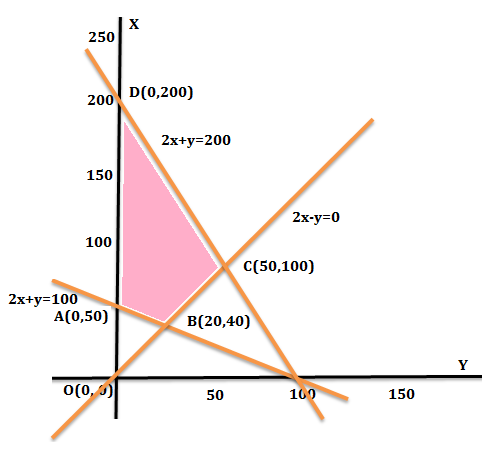
Minimize and maximize $Z=x+2y$ subject to constraints are $x+2y\ge 100,2x-y\ge 0,2x+y\le 200$ and $x,y\ge 0$.
Answer
602.4k+ views
Hint: The corner points are the vertices of the feasible region. Once you have the graph of the system of linear inequalities, then you can look at the graph and easily tell where the corner points are. You may need to solve a system of linear equations to find some of the coordinates of the points in the middle.
Complete step-by-step answer:
Consider equations obtained by converting all inequalities representing the constraints and draw the corresponding lines.
\[\begin{align}
& x+2y=100..............(1) \\
& 2x-y=0..................(2) \\
& 2x+y=200..............(3) \\
\end{align}\]

As $x\ge 0,y\ge 0$ solution lies only in the first quadrant. From the graph ABCD is the feasible region.
We get the intersection of the line (1) with the coordinate axes at points (100, 0) and (0, 50).
Similarly, we get the intersection of the line (2) with the coordinate axes at points (0, 0) and (0, 0) and the line (3) with the coordinate axes at points (100, 0) and (0, 200).
The common shaded region is a feasible region with corner points A(0, 50), B(20, 40), C(50,100) and D(0, 200).
Let us find values of the objective function z = x+2y at the corner points A, B, C, and D respectively.
Z (A) = 0 + 2(50) = 100
Z (B) = 20 + 2(40) = 20 + 80 = 100
Z (C) = 50 + 2(100) = 50 + 200 = 250
Z (D) = 0 + 2(200) = 0 + 400 = 400
The maximum value of the objective function Z is 400 at (0, 200) and the minimum value of the objective function Z is 100 at all the points on the line segment joining the points (0, 50) and (20, 40).
Note: The possibility for the mistake is that you might get confused with the concept that, each corner point is the intersection of two lines, but not every intersection of two lines is a corner point.
Complete step-by-step answer:
Consider equations obtained by converting all inequalities representing the constraints and draw the corresponding lines.
\[\begin{align}
& x+2y=100..............(1) \\
& 2x-y=0..................(2) \\
& 2x+y=200..............(3) \\
\end{align}\]

As $x\ge 0,y\ge 0$ solution lies only in the first quadrant. From the graph ABCD is the feasible region.
We get the intersection of the line (1) with the coordinate axes at points (100, 0) and (0, 50).
Similarly, we get the intersection of the line (2) with the coordinate axes at points (0, 0) and (0, 0) and the line (3) with the coordinate axes at points (100, 0) and (0, 200).
The common shaded region is a feasible region with corner points A(0, 50), B(20, 40), C(50,100) and D(0, 200).
Let us find values of the objective function z = x+2y at the corner points A, B, C, and D respectively.
Z (A) = 0 + 2(50) = 100
Z (B) = 20 + 2(40) = 20 + 80 = 100
Z (C) = 50 + 2(100) = 50 + 200 = 250
Z (D) = 0 + 2(200) = 0 + 400 = 400
The maximum value of the objective function Z is 400 at (0, 200) and the minimum value of the objective function Z is 100 at all the points on the line segment joining the points (0, 50) and (20, 40).
Note: The possibility for the mistake is that you might get confused with the concept that, each corner point is the intersection of two lines, but not every intersection of two lines is a corner point.
Recently Updated Pages
A man running at a speed 5 ms is viewed in the side class 12 physics CBSE

The number of solutions in x in 02pi for which sqrt class 12 maths CBSE

State and explain Hardy Weinbergs Principle class 12 biology CBSE

Write any two methods of preparation of phenol Give class 12 chemistry CBSE

Which of the following statements is wrong a Amnion class 12 biology CBSE

Differentiate between action potential and resting class 12 biology CBSE

Trending doubts
What are the major means of transport Explain each class 12 social science CBSE

Draw ray diagrams each showing i myopic eye and ii class 12 physics CBSE

Draw a ray diagram of compound microscope when the class 12 physics CBSE

Give simple chemical tests to distinguish between the class 12 chemistry CBSE

Using Huygens wave theory derive Snells law of ref class 12 physics CBSE

Dihybrid cross is made between RRYY yellow round seed class 12 biology CBSE




